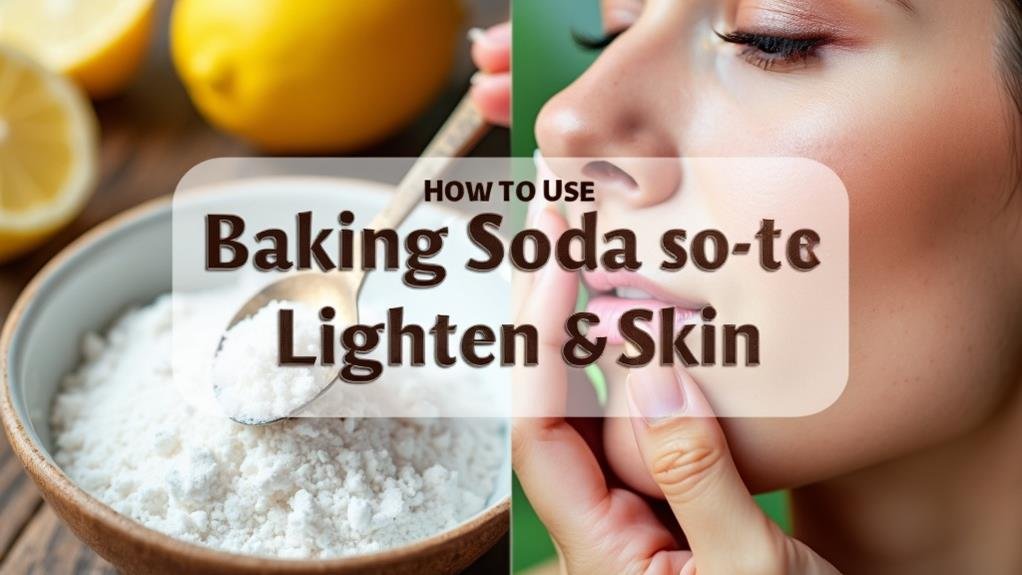If you want to lighten your skin naturally, baking soda may be one option to investigate. You can make a simple paste by combining it with water, but the procedure does not end there. Combining it with other components such as lemon juice or honey may enhance its effects. However, it is critical to understand how this treatment interacts with your skin type and any potential reactions you may experience. Curious about the best recipes and safety precautions? There’s more to learn about this topic.
Baking soda as an exfoliant.

Baking soda is a strong yet gentle exfoliator that may completely change your skin. Baking soda’s fine texture works as a mild abrasive, efficiently exfoliating dead skin cells. This technique promotes a smoother, brighter complexion, which gives your skin a more youthful appearance over time.
You don’t have to worry about irritation because baking soda is soft enough for sensitive skin, allowing you to exfoliate frequently without discomfort.
Begin by making a paste out of baking soda and water. For the best effects, apply this combination to your skin once or twice per week. Not only does this aid to remove dead skin, but baking soda’s alkaline nature also regulates your skin’s pH levels.
This balance can help to achieve a more luminous skin tone, making your entire complexion appear healthier.
Acne Treatment With Baking Soda

In the domain of tackling acne, baking soda‘s unique properties make it a valuable ally in your skincare routine. This common kitchen ingredient has antiseptic and anti-inflammatory qualities that can help reduce the redness and swelling often associated with breakouts. When you mix baking soda with water to create a simple paste, you can apply it directly to acne-prone areas for targeted treatment.
One of the best things about baking soda is its mild abrasive nature, which helps exfoliate your skin. By gently scrubbing with this paste, you can unclog your pores, clearing away dead skin cells and preventing future breakouts. Regular use of baking soda as an acne treatment might lead to fewer flare-ups and an overall improvement in your skin’s texture.
However, it’s essential to be cautious, especially if you have sensitive skin. Always monitor for any irritation after using baking soda, as everyone’s skin reacts differently. If you notice any discomfort, it’s best to reduce the frequency of use or consult a dermatologist.
With the right approach, baking soda can be a helpful addition to your acne-fighting arsenal.
Lightening Blemishes Naturally
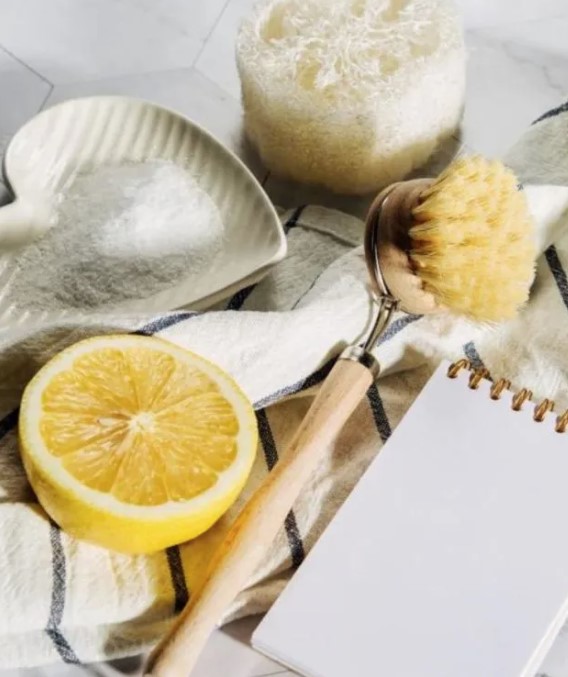
If you’re looking for a natural way to lighten blemishes, consider using a simple baking soda paste. By mixing baking soda and water in a 2:1 ratio, you create a gentle exfoliant that helps remove dead skin cells. This process promotes new skin turnover, which can gradually reduce the appearance of dark spots.
For added benefits, try combining baking soda with lemon juice. This mixture has natural bleaching properties that can effectively lighten blemishes over time.
If you prefer something more moisturizing, mix baking soda with honey. Honey not only hydrates your skin but also has antibacterial benefits that can help keep your skin clear.
Applying these baking soda mixtures 2-3 times a week can lead to more even skin tone, making those pesky blemishes less noticeable. However, it’s essential to patch test any new mixture on a small area of your skin first to avoid irritation.
Dark Neck Skin Solutions
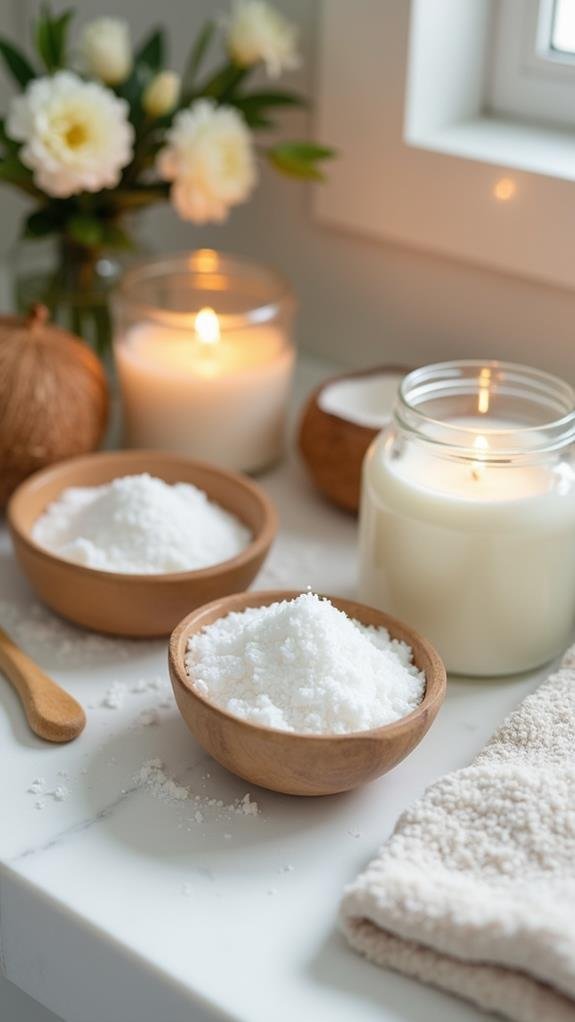
Many people struggle with dark neck skin, but there are effective solutions to help lighten this area. One popular method involves using baking soda mixed with rose water. This combination serves as a powerful skin lightening agent that can improve your complexion when applied as a mask for about 15 minutes.
To prepare this simple paste, just mix equal parts of baking soda and rose water. Apply it gently to your neck, and then rinse it off with warm water afterward. For best results, you should use this treatment 1-2 times per week. Regular use can promote a glowing appearance and help address any discoloration in the neck area.
Before diving in, remember to conduct a patch test first. This guarantees that your skin can tolerate the baking soda without irritation. If everything feels good, you can enjoy the benefits of this natural remedy.
Safety Precautions to Consider
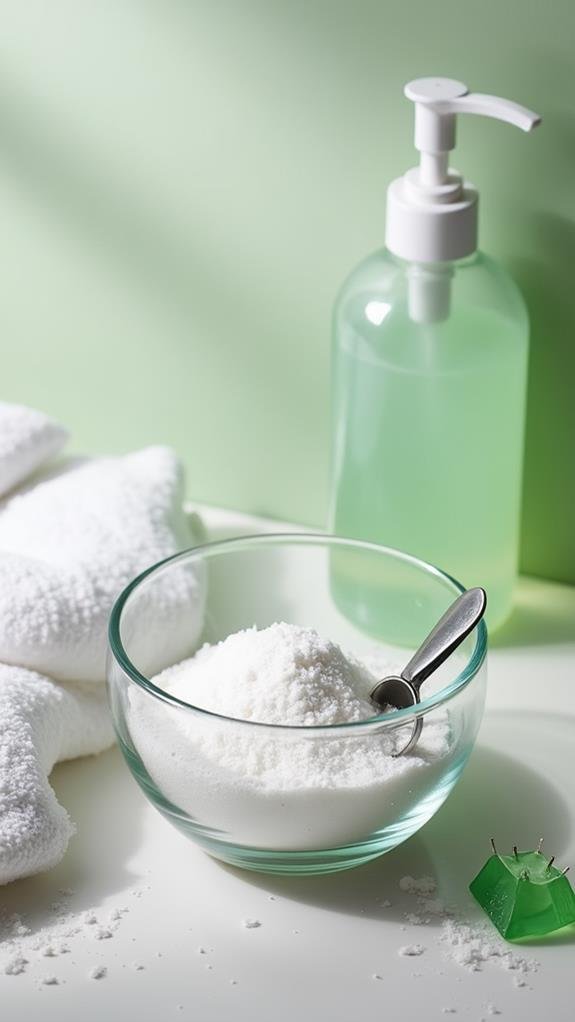
When using baking soda for skin lightening, it’s crucial to prioritize safety. First, always conduct a patch test on a small area of your skin before applying it more widely. This step helps you check for any adverse reactions since baking soda’s alkaline nature can irritate sensitive skin.
After testing, monitor for signs of redness or irritation. If you notice any discomfort, stop using it immediately to prevent further skin damage.
Limit your baking soda applications to just 1-3 times a week. Overdoing it can lead to over-exfoliation, which may cause dryness or irritation. Additionally, be cautious about applying baking soda to broken or inflamed skin, as this could worsen irritation and delay healing.
If you have pre-existing skin conditions or concerns about using baking soda for skin lightening, it’s wise to consult with a dermatologist. They can provide personalized advice to guarantee your safety and effectiveness.
Effective Baking Soda Recipes
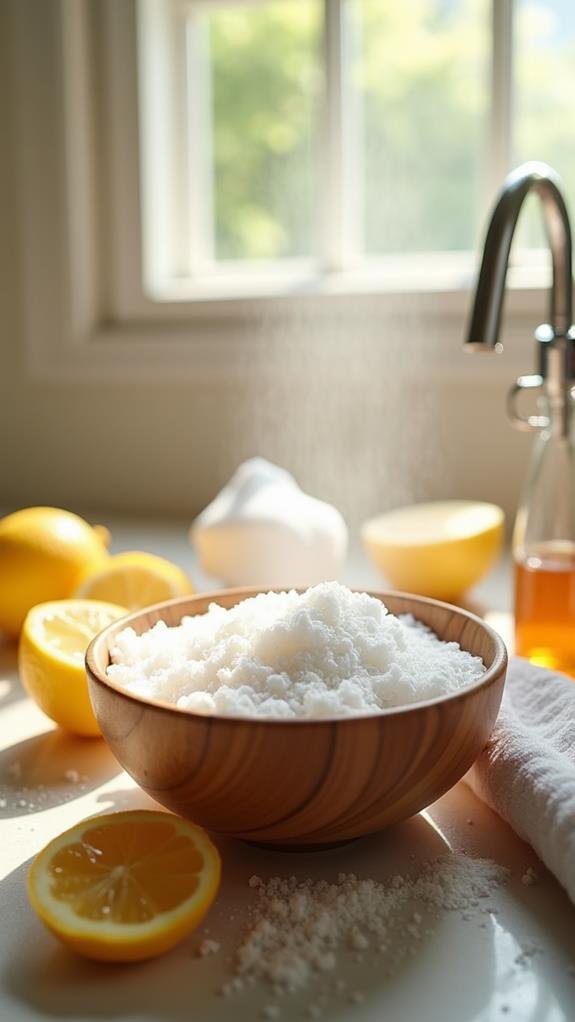
With safety precautions in mind, you can investigate various effective baking soda recipes for skin lightening. One simple method is to create a baking soda paste by mixing two parts baking soda with one part water. Apply this paste to the desired area for a few minutes, then rinse thoroughly.
If you want something more nourishing, combine one tablespoon of baking soda with two tablespoons of honey. Leave the mixture on your skin for 15-20 minutes before washing it off for added brightness.
You can also mix half a lemon’s juice with half a teaspoon of baking soda. Apply it gently to your skin and rinse after a few minutes to take advantage of lemon’s natural bleaching properties.
For a revitalizing exfoliating treatment, combine three tablespoons of apple cider vinegar with two tablespoons of baking soda, apply for 15 minutes, and rinse with lukewarm water.
Alternative Skin Lightening Options
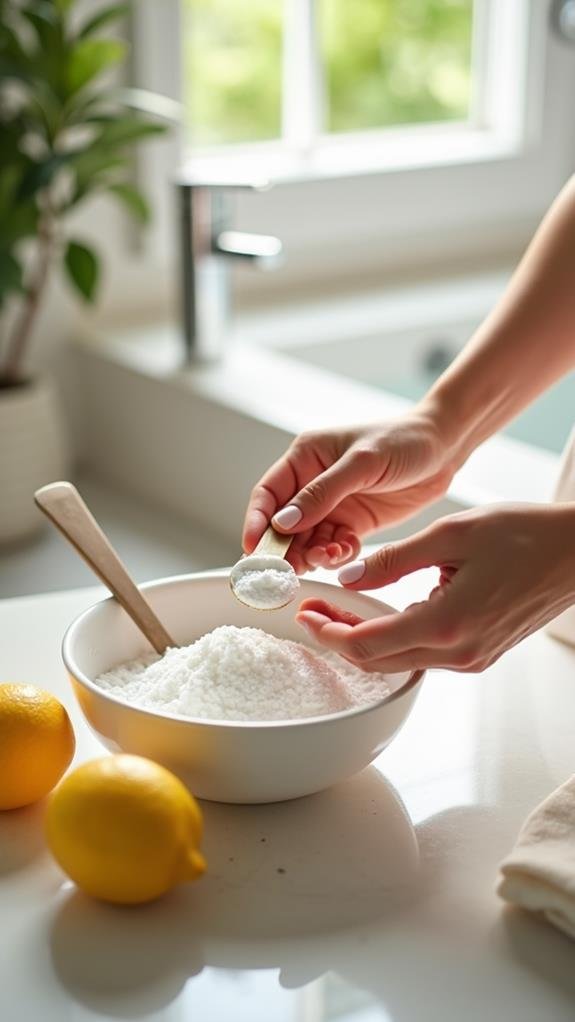
Exploring alternative skin lightening options can provide you with a variety of effective methods to achieve an even skin tone. One popular natural remedy is lemon juice, known for its natural bleaching properties. When applied regularly, it can help lighten your skin.
Another great choice is aloe vera, which not only soothes but also lightens skin and reduces blemishes over time, promoting a healthier appearance.
Coconut oil is another fantastic option. It hydrates your skin while containing antioxidants that may improve skin tone and help reduce discoloration.
For those looking for quicker results, commercial products are available. Many over-the-counter skin lightening creams contain hydroquinone, which is well-known for its effectiveness in tackling hyperpigmentation.
If you’re seeking professional help, dermatologists can offer tailored solutions like chemical peels and laser treatments. These methods can provide significant skin lightening results, ensuring that you find the best option for your needs.
Understanding Skin Reactions
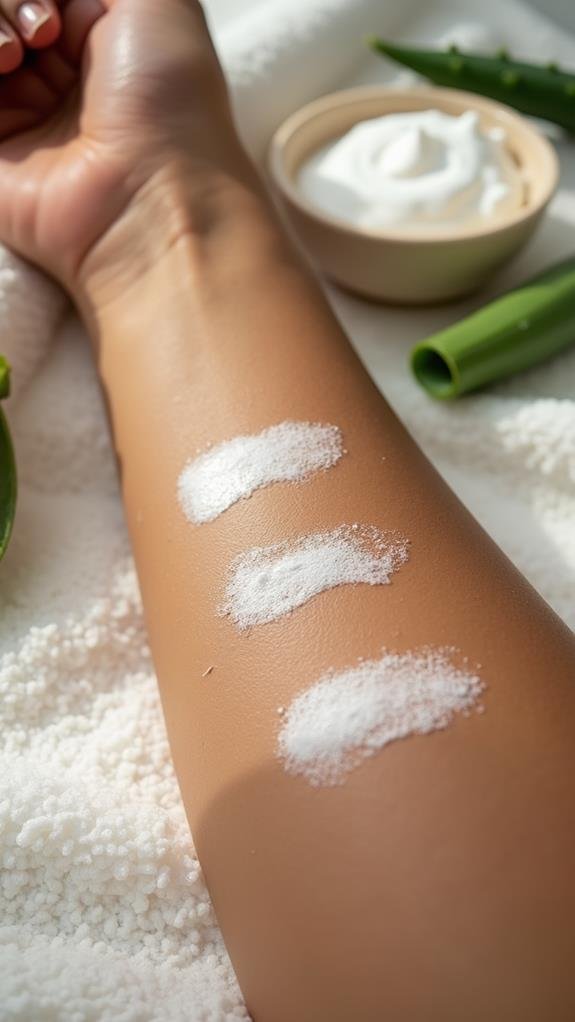
Understanding how your skin reacts to different treatments is essential for achieving safe and effective results. When you use baking soda, it’s important to keep in mind that it has an alkaline pH of about 8.3, while your skin’s natural pH balance is between 4.5 and 5.3. This difference can lead to skin reactions, especially if you have sensitive skin.
To avoid irritation, always conduct a patch test on a small area before applying it more widely.
You might notice redness or irritation if you overuse baking soda. It can strip away your skin’s natural oils, leading to dryness. While some people find baking soda helpful for skin lightening, results can vary.
For some, the irritation may outweigh the benefits, so it’s vital to monitor your skin closely. If you experience burning sensations or excessive dryness, it’s best to stop using it and consult a dermatologist.
Keep in mind, your skin deserves care and attention, so listen to what it tells you about how it reacts to baking soda.
Long-Term Skin Care Strategies
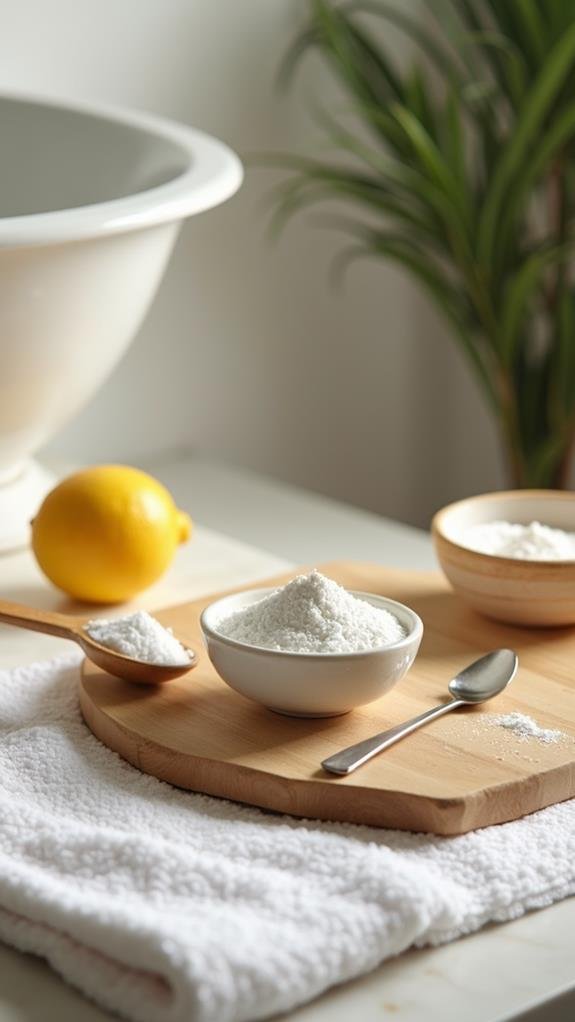
Long-term skin care strategies are important for maintaining a healthy and radiant complexion while using baking soda. To get the best results from baking soda, you should apply it as an exfoliant 3-4 times a week. This helps improve your skin texture and promotes a brighter tone.
Don’t forget to mix in natural lightening agents like lemon juice or honey, as they can work wonders to reduce blemishes over time. Keeping your skin’s pH balanced is essential, so always include a good moisturizer in your routine. Protecting your skin from the sun is significant as well, since sun damage can counteract your hard work.
Before applying any baking soda mixtures on larger skin areas, conduct patch tests to avoid irritation and verify compatibility with your skin type. For the best results, consider consulting with a dermatologist. They can provide tailored skin care strategies that address your specific concerns and help you achieve your desired outcomes.
Conclusion
To summarize, using baking soda for skin lightening can be effective if done safely. By mixing it with water, lemon juice, or honey, you can create a helpful paste for your skin. Remember to patch test before applying any new treatment, and don’t overdo it—2-3 times a week is enough. If you’re looking for alternative options or have concerns about skin reactions, consider consulting a dermatologist. With the right care, you can achieve a brighter complexion!

